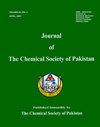TiO2纳米颗粒和含n化合物体系中苯酚的降解
IF 0.5
4区 化学
Q4 CHEMISTRY, MULTIDISCIPLINARY
Journal of the chemical society of pakistan
Pub Date : 2023-01-01
DOI:10.52568/001192/jcsp/45.01.2023
引用次数: 0
摘要
本研究的目的是研究纳米TiO2和3-氨基乙酸甲酯存在下紫外辐射对水中苯酚的分解。在含TiO2+N物质体系中进行了紫外存在下苯酚的光化学分解。反应中使用的TiO2纳米颗粒尺寸为10 ~ 30 nm,属于金红石相。采用x射线衍射、透射电镜和扫描电镜等方法对纳米tio2进行了研究。所有的XRD峰都很清晰,与金红石相TiO2相对应。从Scherrer衍射峰(101)的谱线展宽来看,TiO2的平均晶粒尺寸约为10.3。TiO2的比表面积为159.6 m2/g。在Rigaku Mini Flex 600s粉末衍射仪上记录了所研究纳米复合材料的x射线结构分析图。采用铜阳极(Cu-Kα辐射,30 kV, mA) x射线管在室温下绘制衍射谱图。在2θ = 20和#176;- 80和#176;在离散生长模式下,这些谱为Δ2θ = 0.05, #176;曝光时间τ =5秒。采用溶胶-凝胶法合成极少量的白色粉末和0.05 gr的TiO2纳米颗粒以及含n物质,光化学过程持续1小时。工艺中苯酚溶液用量为1 mg -1。用瓦里安Cary 50分光光度计监测该过程。苯酚光化学分解后,反应产物在Agilent 6980N/5975上采用GC-MSD法进行分析。目的是确定苯酚在TiO2+N体系中光化学分解的百分比,并确定苯酚的分解率为60%。本文章由计算机程序翻译,如有差异,请以英文原文为准。
Degradation of Phenol in the System TiO2 Nanoparticles and N-Containing Compound
The purpose this research was to study the decomposition of phenol in water under the influence of UV radiation in the presence of nanoparticles TiO2 and methyl-3-amicrotonate. The photochemical decomposition of phenol in the presence of UV in a system of TiO2+N containing substances was carried out. The TiO2 nanoparticles used in the reaction had a size from 10 to 30 nm and belonged to the rutile phase. Nano-TiO2 was studied by X-ray diffraction, TEM and SEM methods. All the XRD peaks were well-defined and corresponded to rutile phase TiO2. From the line broadening of the (101) diffraction peak by Scherrer’s method, the average crystal size TiO2 is about 10.3. The specific surface areas for TiO2 is 159.6 m2/g. X-ray structure analysis Fig of the studied nanocomposite materials were recorded on the Rigaku Mini Flex 600s powder diffractometer. X-ray tube with copper anode (Cu-Kα radiation, 30 kV and mA) was used to draw the diffraction specters at room temperature. At 2θ = 20and#176;- 80and#176; with discrete growth mode these specters were obtained as Δ2θ = 0.05and#176; and the exposure time was τ =5 seconds. The photochemical process lasted 1 hour using a very small amount of white powder and 0.05 gr of TiO2 nanoparticles synthesized by the sol-gel method and N-containing substance. For the process 1 mgL-1of phenol solution was used. The process was monitored with a spectrophotometer “Varian Cary 50”. After the photochemical decomposition of phenol, the reaction product was analyzed on an Agilent 6980N/5975 by the method GC-MSD. The goal was to determine the percentage of photochemical decomposition of phenol in TiO2+N system and 60% decomposition of phenol was defined.
求助全文
通过发布文献求助,成功后即可免费获取论文全文。
去求助
来源期刊
CiteScore
1.30
自引率
14.30%
发文量
41
审稿时长
3.4 months
期刊介绍:
This journal covers different research areas in the field of Chemistry. These include; Analytical Chemistry, Applied Chemistry, Biochemistry, Environmental Chemistry, Industrial Chemistry, Inorganic Chemistry, Organic Chemistry and Physical Chemistry. The journal publishes full length articles and Reviews from researchers in academia in addition to featuring comments. Chemical Research presents short, concise and critical articles offering easy-to-read overviews of basic research and applications in all areas of chemistry.

 求助内容:
求助内容: 应助结果提醒方式:
应助结果提醒方式:


